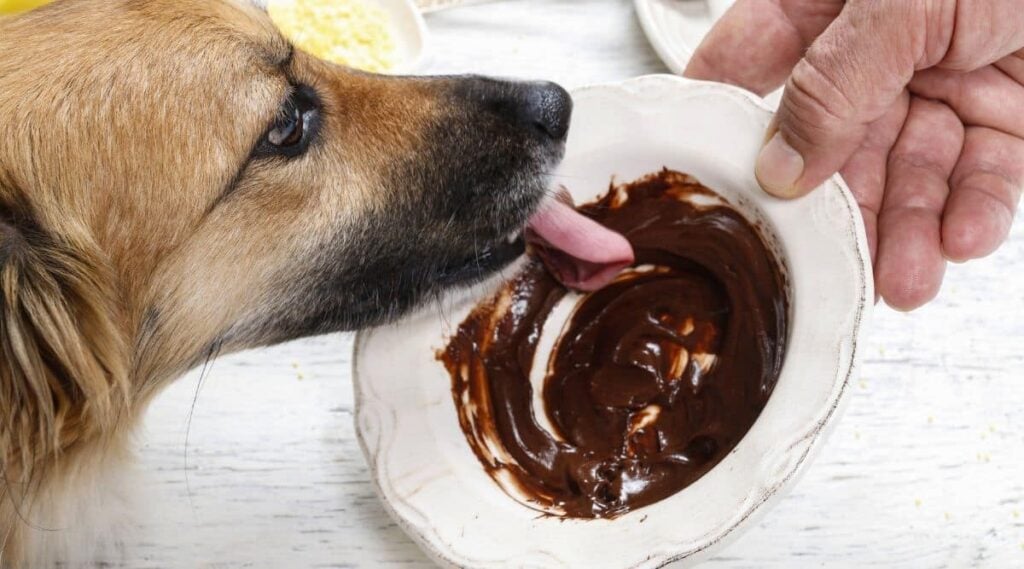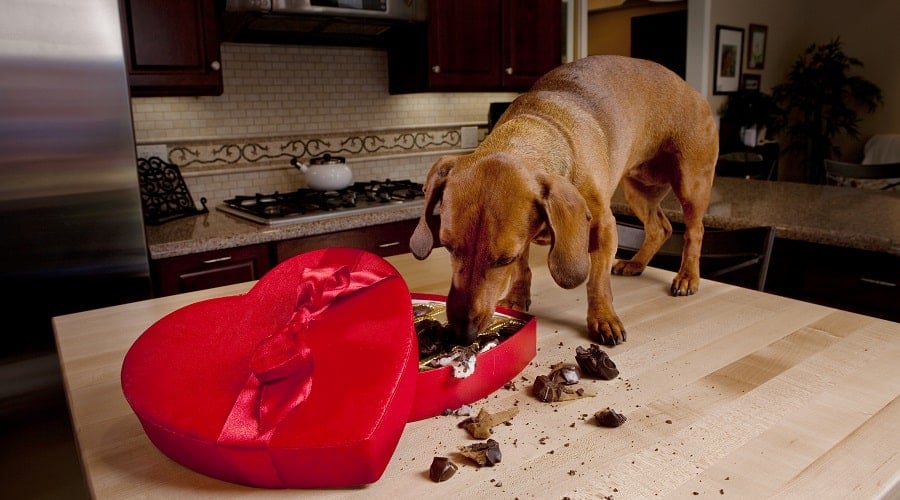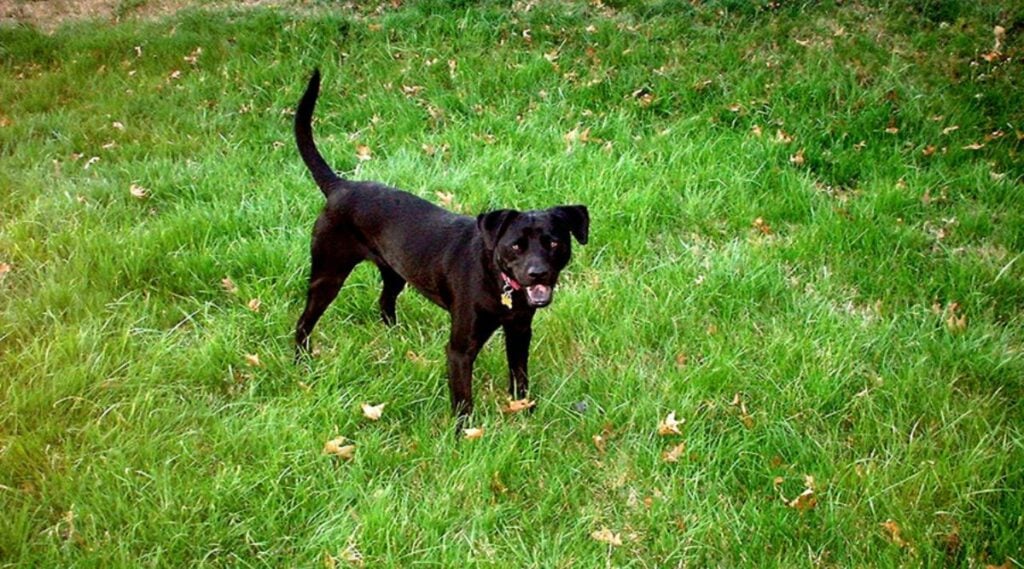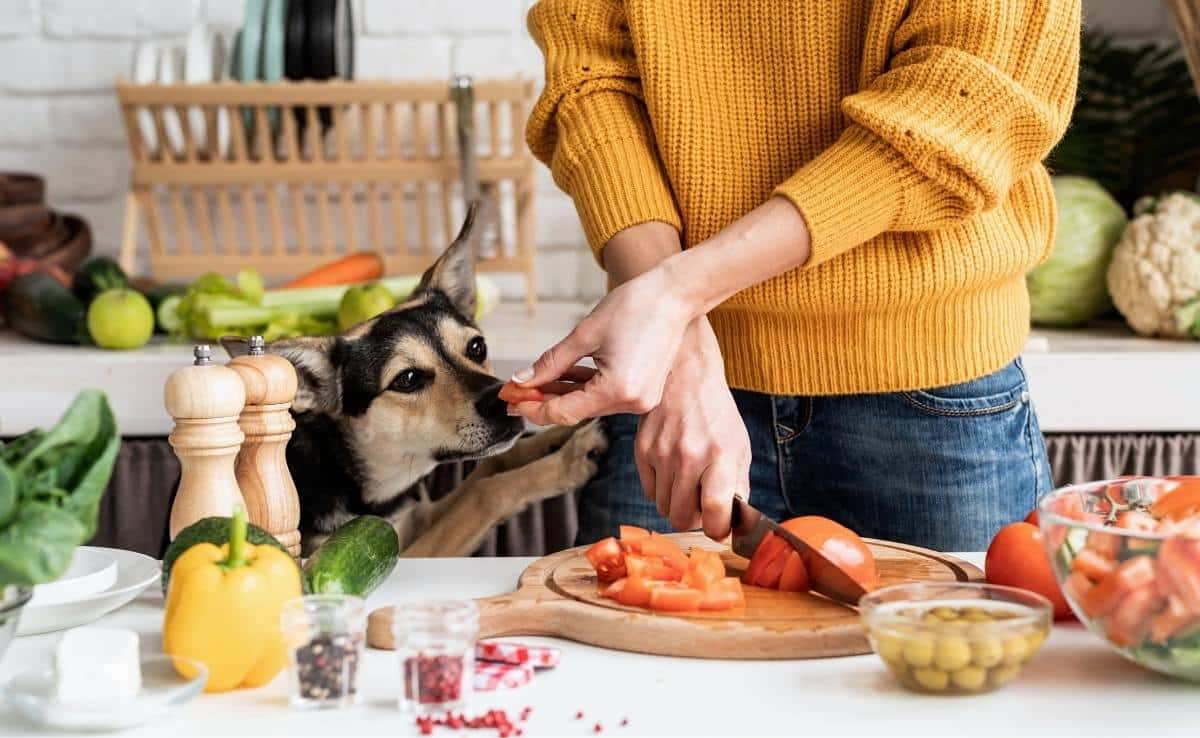Did Your Dog Eat Chocolate? Symptoms, Risks & What To Do Immediately!
When you purchase through links on our site, we may earn a commission. Here’s how it works.
Think a little chocolate won’t hurt your dog? Think again. If you’re wondering, “Can dogs eat chocolate?” it’s crucial to know that even a small amount of chocolate can be dangerous or deadly for dogs.
Table of Contents
Packed with theobromine and caffeine, chocolate is toxic to dogs and can trigger symptoms like vomiting, seizures, and, in severe cases, heart failure.
In this guide, you’ll learn exactly what to do if your dog eats chocolate, how to recognize the signs of chocolate poisoning, and which types of chocolate are the most dangerous. Don’t wait until it’s too late because knowing the risks could save your pet’s life.

What To Do If Your Dog Eats Chocolate: 5 Steps
If your dog just ate chocolate, don’t panic. But you need to act fast. Chocolate contains theobromine and caffeine, two substances that are toxic to dogs and can cause serious health problems. The steps you take in the next few minutes matter.
We have a separate guide on what to do if your dog has eaten chocolate. But if you suspect your pup has consumed chocolate, it’s best to follow these steps and call your vet immediately for advice.
1. Stay Calm & Quickly Gather Key Info
You’ll need to know:
- What type of chocolate it was (dark, milk, white, baking)
- How much your dog might have eaten
- Your dog’s weight
- How long ago the chocolate was consumed
Why This Matters: Dark and baking chocolates contain higher levels of theobromine, making them more toxic in smaller amounts.
2. Call A Vet Or Pet Poison Hotline Immediately
Don’t wait for symptoms. Contact a veterinary professional right away:
- ASPCA Poison Control: (888) 426-4435
- Pet Poison Helpline: (855) 764-7661
- Your local emergency vet clinic
These experts will help assess the danger based on your dog’s weight and the type/amount of chocolate consumed.
3. Don’t Induce Vomiting Unless Told To Do So
Never attempt to make your dog vomit unless a vet or poison control center has instructed you. Doing it incorrectly can make things worse, especially in small breeds or senior dogs.
4. Monitor For Symptoms Of Chocolate Poisoning
Watch your dog closely for signs like:
- Vomiting or diarrhea
- Restlessness or pacing
- Rapid breathing or abnormal heartbeat
- Muscle tremors or seizures
If any of these appear, go to the emergency vet immediately.
5. Take The Chocolate Packaging With You
If you’re going to a vet, bring the chocolate wrapper or label. It helps them identify the type of chocolate and estimate the theobromine dosage more accurately.
If your dog ate not just the chocolate but also the wrapper or packaging, let them know that too. Plastic, foil, or candy wrappers can cause choking, blockages, or other complications that may require separate treatment from the chocolate itself.
Pro Tip: Even small amounts of dark chocolate can be deadly for small dogs. Never wait to “see what happens”. Timing can be the difference between recovery and danger.
Is Chocolate Toxic To Dogs?
Yes, chocolate is toxic to dogs, and in some cases, even a small amount can lead to severe poisoning. So, can dogs eat chocolate? No, and the danger lies in two key compounds:
- Theobromine. The primary toxin. Dogs process theobromine very slowly, allowing it to build up to dangerous levels.
- Caffeine. It is present in smaller amounts, but it adds to the toxic effects, especially on the heart and nervous system.
Theobromine is the primary toxin in chocolate, with concentrations up to 10 times higher than caffeine. While both substances contribute to chocolate poisoning, dogs are especially vulnerable because they metabolize theobromine and caffeine much more slowly than humans.
This slow processing allows the chemicals to accumulate in their system, potentially leading to elevated heart rate, overstimulation of the nervous system, and serious secondary health complications like seizures or cardiac arrest.

Toxicity Depends On 3 Factors
1. Type of Chocolate
- Dark chocolate, cocoa powder, and baking chocolate have the highest theobromine levels.
- Milk chocolate is less potent but still dangerous.
- White chocolate contains very little theobromine but can still cause stomach upset.
2. Amount Consumed
- Just 0.3 ounces of dark chocolate per pound of body weight can be toxic.
- For small dogs, even a bite can trigger symptoms.
Eating a crumb of chocolate off the floor shouldn’t cause a huge problem, but you should do everything possible to keep chocolate away from them.
3. Dog’s Size and Health
- Smaller breeds, puppies, and dogs with underlying conditions are more at risk.
What Chocolate Does To A Dog’s Body
Theobromine affects:
- The central nervous system (tremors, seizures)
- The cardiovascular system (increased heart rate, arrhythmia)
- The digestive system (vomiting, diarrhea)
- The urinary system (increased thirst and urination)
In high doses, chocolate poisoning can cause:
- Internal bleeding
- Heart failure
- Death
Bottom Line: Chocolate is not just a treat. It’s a toxin for dogs. Always treat chocolate ingestion seriously and act quickly, especially with dark or baking chocolate.
How Much Chocolate Is Poisonous To A Dog?
Not all chocolate is created equal, and neither are all dogs. The amount of chocolate that becomes toxic depends on a combination of the type of chocolate, the amount consumed, and your dog’s weight.

Theobromine Content By Chocolate Type
The MSD Veterinary Manual lists a few types of chocolate in order of theobromine content (highest to lowest):
- Cocoa powder (800mg/oz)
- Unsweetened baker’s chocolate (450mg/oz)
- Cocoa bean hulls (255mg/oz)
- Dark and semisweet chocolate (150-160mg/oz)
- Milk chocolate (64mg/oz)
- White chocolate (0.25mg/oz)
Chocolate is made from cocoa beans, which naturally contain theobromine, which is the primary chemical that causes chocolate toxicity in dogs. The darker and more concentrated the chocolate, the higher the theobromine content.
Cocoa powder and unsweetened baker’s chocolate have a much higher concentration of theobromine than milk chocolate and white chocolate. Although white chocolate rarely poses any threat of chocolate toxicity to dogs, it’s still best to avoid it due to the high amounts of sugar and fat.
Dangerous Amounts Based On Dog’s Weight
How much chocolate is poisonous to a dog also depends on the size of your dog. According to the MSD Vet Manual:
- Mild Symptoms: ~20 mg/kg of body weight
- May include vomiting, diarrhea, restlessness, or increased thirst
- Moderate to Severe Symptoms: ~40–50 mg/kg
- Can trigger cardiac issues such as elevated heart rate or arrhythmias
- Severe Toxicity: ~60+ mg/kg
- May lead to muscle tremors, seizures, or even death
Because toxicity is dose-dependent on body weight, small dogs are at much higher risk, even with small amounts. For example, a 10-pound dog eating a single square of baking chocolate could require emergency care.
To put it into perspective, an average Hershey’s milk chocolate bar weighs 1.55 oz. So, eating just one chocolate bar can have disastrous consequences, especially for a tiny pooch.
Chocolate Toxicity Calculator
Use the MSD Veterinary Manual’s chocolate toxicity calculator to estimate risk based on your dog’s weight and the type of chocolate ingested. But always confirm with your vet.
Symptoms Of Chocolate Poisoning In Dogs?
Chocolate poisoning doesn’t always show up right away. Symptoms usually appear within 6 to 12 hours after ingestion and may last for up to 72 hours, depending on the dose and the dog’s size. Symptoms can show quicker in smaller or older dogs or those with heart conditions.
If your dog has eaten chocolate, monitor closely for these signs:
Early Symptoms
- Vomiting
- Diarrhea
- Drooling or excessive thirst
- Restlessness or hyperactivity
- Panting or increased heart rate
Escalating Symptoms
- Muscle tremors
- Incoordination or wobbliness
- Rapid breathing
- Increased urination
- Elevated body temperature (fever)
Emergency Symptoms
- Seizures
- Collapse or unconsciousness
- Irregular heartbeat
- Signs of internal bleeding (pale gums, bloody stool)
- Unresponsiveness
Some symptoms may not appear for several hours. Just because your dog “seems fine” doesn’t mean they’re safe. Always consult a vet if chocolate is ingested.
When To Call The Vet vs. Induce Vomiting At Home
When your dog eats chocolate, jumping into action is tempting, but not every situation calls for home remedies. In fact, trying to induce vomiting without veterinary guidance can do more harm than good.
When You Should Call A Vet Immediately
- You don’t know how much chocolate your dog ate
- Your dog is showing any symptoms (vomiting, shaking, pacing, etc.)
- Your dog is very small, elderly, a puppy, or has pre-existing health issues
- The chocolate was dark, baking, or cocoa powder
- Your dog has a history of seizures or heart problems
You should never attempt to make your dog vomit unless you’ve spoken to a veterinarian or poison control expert first. Inducing vomiting without proper guidance can be dangerous, especially if your dog is already lethargic, vomiting, struggling to breathe, or having a seizure.
If more than two hours have passed since the chocolate was eaten, or if you don’t have vet-approved hydrogen peroxide and correct instructions, it’s even riskier. It can lead to a variety of health problems, including aspiration or choking.
Check out our guide on Dr. Cuddle’s ReadyRESCUE, a pet-safe detox kit that contains three activated carbon vials. While it may help buy you valuable time before reaching the vet, it should only be used under veterinary guidance to ensure it’s appropriate for your dog’s situation.
What Happens At The Vet If Your Dog Eats Chocolate
If your dog has consumed a toxic amount of chocolate or is showing any symptoms, don’t wait. Get them to a vet or emergency animal clinic immediately.
Here’s what typically happens during treatment for chocolate toxicity:
1. Assessment
The vet will ask:
- What type and how much chocolate your dog ate
- When it was consumed
- Your dog’s weight, breed, and current symptoms
They may also request to see the chocolate packaging to estimate theobromine content.

2. Induce Vomiting
If the chocolate was consumed within the last 1–2 hours, and your dog is stable, the vet may induce vomiting to expel as much theobromine as possible before it enters the bloodstream.
3. Activated Charcoal
To prevent further absorption, the vet may administer activated charcoal orally. This binds to any remaining theobromine in the stomach or intestines.
4. IV Fluids & Supportive Care
If symptoms are present, your dog will likely receive:
- IV fluids to flush toxins and prevent dehydration
- Medications to control seizures, arrhythmias, or tremors
- Heart monitoring and temperature regulation
5. Observation & Hospitalization
Your dog may be monitored at the clinic for 12 to 72 hours, depending on the severity of symptoms and the amount ingested. The goal is to:
- Stabilize heart rate and rhythm
- Prevent organ damage
- Ensure complete toxin elimination
There is no antidote for theobromine toxicity. Early intervention and supportive treatment are the only way to reduce the risk of long-term harm or fatality.
How Pet Insurance Can Help
Emergency vet care can be expensive, especially when dealing with chocolate toxicity. Treatment costs typically range from $250 to over $3,000, depending on the severity and how quickly it’s addressed. But it can be much more. That’s why it’s wise to consider pet insurance before an emergency strikes. So you’re prepared to protect your dog without hesitation when it matters most.
Real Story: My Dog Ate Cocoa Powder & Here’s What Happened
Read about our team member’s experience when their black Lab, Storm, got into cocoa powder and how it almost became a life-threatening emergency.

I went to Amsterdam for work a few years ago and came back with a coveted boc of Van Houten Dutch Cocoa for my family to enjoy in hot cocoas. But, before I could store it in the cupboard, my black Lab, Storm, sniffed it out in my bag and took the liberty of helping himself to the tasty treat.
Cocoa powder is the most toxic to dogs of all chocolates and he was almost immediately vomiting it back up. I called the vet and they said that since he did not eat very much before he started immediately vomiting he should be okay, especially if we can tell he gets it all out of his system.
They also instructed us to keep a close eye on him for unusual behavior in the next 24 hours. Luckily, he threw up a few more times and then was completely himself again.
If his body had allowed time for the cocoa to digest and work into his system before rejecting it, we would’ve had a long night in the emergency vet. We were lucky but learned to NEVER ever leave chocolate anywhere a dog can possibly be tempted!
– Michelle Schenker, Dog Parent and Co-Founder of Canine Journal
5 Ways To Prevent Chocolate Poisoning In Dogs
The best way to protect your dog from chocolate toxicity is to stop it from happening in the first place. Prevention is simple, effective, and can save you a costly and traumatic emergency vet visit.
1. Store Chocolate Out Of Reach
Dogs love exploring and eating, so they forever eat things they shouldn’t. And because chocolate is sweet and delicious, it’s hard to resist.
- Keep all chocolate products in high cabinets or sealed containers
- Don’t leave chocolate on countertops, coffee tables, or bags on the floor
Pro Tip: Chocolate is one of the most common causes of pet poisoning during holidays. Being proactive about storage and education can prevent an emergency before it starts.
2. Don’t Share Human Treats
- Even small amounts of dark or baking chocolate can be toxic, especially for small breeds
- Never assume “just a bite” is safe, it’s not worth the risk
3. Warn Guests, Kids & Caregivers
- Make sure visitors, kids, and pet sitters know not to feed your dog chocolate or desserts
- Use simple signs or labels on pet-safe treats during gatherings
4. Know Your Dog’s Behavior
- If your dog is a known “counter surfer” or chewer, assume everything within reach is fair game
- Use dog gates or crate training during high-risk times (like parties or holidays)
- Teaching your pooch the “leave it” command is extremely helpful in preventing dogs from eating something dangerous or toxic
Watch this short training video from a canine behaviorist at Battersea Dogs’ Home, where they demonstrate how to teach your dog the “leave it” command.
5. Offer Safe Alternatives
- Keep dog-safe treats on hand, so you’re not tempted to share sweets
- Check out our list of dog-safe chocolate alternatives up next
Dog-Safe Alternatives To Chocolate
You don’t have to feel guilty for enjoying sweets while your dog watches with big, hopeful eyes. Plenty ofhttps://www.caninejournal.com/can-dogs-eat-chocolate/safe and tasty alternatives let your dog indulge without risking their health.
1. Carob (The Dog-Safe Chocolate Substitute)
A dog-safe alternative to chocolate is carob, commonly used in dog treats and just as tasty to dogs.
- Carob looks and tastes similar to chocolate but contains no theobromine or caffeine
- It’s 100% safe for dogs and often used in pet-friendly treats
- Look for unsweetened, dog-formulated carob chips or biscuits
Check out these delicious carob peanut butter cookies or carob sandwich cremes that your pooch is bound to adore.
2. Peanut Butter
Dogs love peanut butter for its rich, savory flavor and creamy texture, making it a tasty and safe alternative to chocolate.
- Natural peanut butter is a protein-packed, dog-approved snack
- Make sure it contains no xylitol, a sweetener that’s toxic to dogs
- Use as a treat filler or freeze inside a Kong for enrichment
Looking for a safe treat? Check out our guide to the best peanut butter for dogs, including which ingredients to avoid and vet-approved options.
3. Fruits Dogs Can Safely Enjoy
Sweet and nutritious alternatives to chocolate include a variety of dog-safe fruits:
These treats are naturally low in fat, packed with vitamins, and perfect for training rewards or an occasional healthy snack. These can be chopped, frozen, or added to a puzzle feeder.
4. Other Dog Treats
Looking for more treat ideas? Explore our guides:
- Low-calorie dog treats
- Best treats for training
- Calming treats
- Freeze-dried treats
- Grain-free homemade treats
- CBD dog treats
- Hypoallergenic dog treats
Frequently Asked Questions About Dogs & Chocolate
Below, I’ve answered some of the most common questions about if dogs can eat chocolate. But if you don’t see yours, feel free to ask in the comments. We’re here to help!
Can Dogs Eat Chocolate?
No, dogs should not eat chocolate. It contains theobromine and caffeine, both of which are toxic to dogs. Even small amounts can cause serious health issues, including vomiting, seizures, or heart problems.
Do Dogs Like Chocolate?
Yes, absolutely. It’s sweet, creamy, and a little bit naughty. What’s not to love? Unfortunately, most dogs feel the same way, too.
Whether it’s in your hand or just lying around, there aren’t many dogs that can resist it. So, as the responsible parent, it’s down to you to prevent them from getting their paws on it.
Can A Small Amount Of Chocolate Hurt My Dog?
Yes, especially if your dog is small or the chocolate is dark or baking chocolate. Even a bite can cause symptoms like vomiting or restlessness. Always consult your vet if you’re unsure.
What Should I Do If My Dog Eats Chocolate But Seems Fine?
Symptoms of chocolate toxicity can take several hours to appear. Call your vet or a pet poison hotline immediately. They’ll assess the risk based on your dog’s size and what was eaten.
How Long After Eating Chocolate Will My Dog Show Symptoms?
Symptoms usually appear within 6 to 12 hours but can take up to 24 hours, depending on dose and metabolism. Signs may last for up to 72 hours in severe cases.
Is Dark Chocolate Worse Than Milk Chocolate For Dogs?
Yes. Dark chocolate and baking chocolate contain much higher levels of theobromine, the toxic compound that makes chocolate dangerous for dogs.
Is White Chocolate Safe For Dogs?
White chocolate contains very low levels of theobromine, so it’s unlikely to cause toxicity in most cases. However, it’s still high in sugar and fat, which can lead to stomach upset or pancreatitis, so it’s best avoided.
How Do Vets Treat Chocolate Poisoning In Dogs?
Treatment may include inducing vomiting, administering activated charcoal, IV fluids, medications, and continuous monitoring, depending on the severity.
Can Chocolate Kill A Dog?
In high enough doses, yes. Chocolate poisoning can lead to seizures, heart failure, and death, particularly in small dogs or when treatment is delayed.
Can Dogs Eat Chocolate Cake?
No, dogs cannot eat chocolate cake. Dogs should not eat chocolate in any form, and chocolate used for baking usually has a higher concentration of theobromine.
So whether the cake has chocolate sauce, chocolate chips, or is flavored with cocoa powder, it’s a huge nope. Even scrumptious chocolate brownies are a no-go.
What Chocolate Can Dogs Eat?
The only chocolate dogs can eat is “chocolatespecifically made for dogs. But your dog should avoid any food containing chocolate not explicitly made for dogs.
Keep Your Dog Healthy Beyond Chocolate Safety
Preventing chocolate toxicity is just one part of protecting your dog’s health. There’s so much more you can do every day to support their well-being.
A high-quality, balanced diet helps your dog stay strong and maintain a healthy weight. With your vet’s go-ahead, adding dog-safe probiotics can support digestion and boost your dog’s immune system.
Brushing your dog’s teeth regularly is one of the easiest ways to prevent dental disease, which is linked to heart and kidney problems later in life. And finally, consistent training not only improves behavior but can also teach your dog to “leave it” when it comes to dangerous foods like chocolate.
Has your dog ever gotten into chocolate? Share your story in the comments because your experience could help another pet parent stay prepared.



